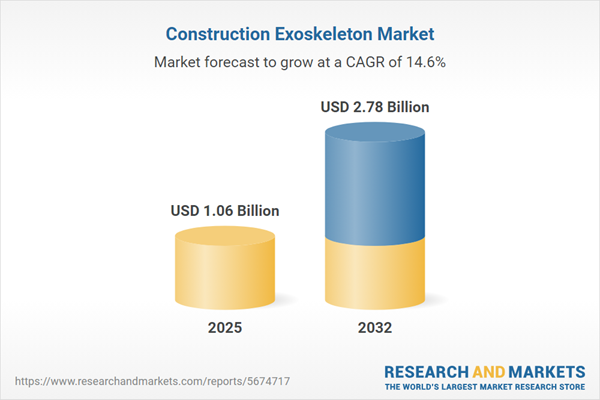Dublin, Oct. 14, 2025 (GLOBE NEWSWIRE) -- The "Construction Exoskeleton Market - Global Forecast 2025-2032" report has been added to ResearchAndMarkets.com's offering.
This report equips industry leaders with clear intelligence to navigate technological, regulatory, and market shifts in the construction exoskeleton space. Strategic insights support confident planning, effective supply chain management, and safe, productive workforce strategies.

The global construction exoskeleton market grew from USD 932.75 million in 2024 to USD 1.06 billion in 2025, with sustained expansion expected through 2032 at a CAGR of 14.63%, reaching USD 2.78 billion. This growth is shaped by robust investment in emerging wearable support technologies, strong regulatory focus on worker well-being, and increased adoption across major global regions.
The construction exoskeleton market is evolving rapidly as senior leaders seek advanced solutions to address workforce productivity, safety, and operational efficiency challenges. Wearable robotic exoskeletons are becoming central to transforming how construction projects are executed and managed.
Tariff Impact: Navigating New Trade Realities
Upcoming United States tariffs on imported exoskeleton components are prompting procurement strategy realignment. Firms are diversifying supplier bases, increasing interest in domestic and regional manufacturers, and forming new alliances to reduce risks from potential disruptions. These changes are also directing R&D focus toward modular product designs that support supply chain agility and proactive compliance. The shift to local service networks ensures that training, repair, and technical support remain robust despite global trade uncertainty.
Key Takeaways
- Wearable exoskeletons are driving notable improvements in worker productivity and injury prevention by providing ergonomic support for demanding construction tasks.
- Digitization enables real-time monitoring of performance metrics, facilitating more effective management of fatigue and onsite safety practices.
- Sustainability and labor market shifts are motivating investment in both active and passive exoskeleton solutions to extend workforce tenure and address skilled labor shortages.
- Device design continues to evolve with advances in lightweight materials, intuitive human-machine interfaces, and modular architectures for easier customization and maintenance.
- Regional adoption patterns reflect differences in regulatory environments, infrastructure priorities, and investment in digital transformation across mature and emerging markets.
Scope & Segmentation
- Product Types: Active Exoskeletons (Full Body, Lower Body, Upper Body for heavy lifting, material handling, overhead work, repetitive motions); Passive Exoskeletons (Full Body, Lower Body, Upper Body for the same applications).
- Body Focus: Full Body, Lower Body, Upper Body (each addressing heavy lifting, material handling, overhead work, repetitive motions).
- Application Areas: Heavy Lifting, Material Handling, Overhead Work, Repetitive Motions, with further differentiation by electric, hydraulic, and spring-powered options.
- Power Source: Electric Powered, Hydraulic Powered, Spring Powered (active and passive variants).
- Distribution Channel: Direct Sales (active and passive systems), Distributor Sales, Online Sales.
Why This Report Matters
- Guides decision-makers in optimizing exoskeleton investments with actionable segmentation and regional analysis.
- Assists in building resilient procurement and deployment strategies amid shifting regulatory and trade environments.
- Delivers a balanced assessment of technology, supply chain considerations, and competitive dynamics to foster sustainable workforce integration.
Key Attributes:
| Report Attribute | Details |
| No. of Pages | 184 |
| Forecast Period | 2025 - 2032 |
| Estimated Market Value (USD) in 2025 | $1.06 Billion |
| Forecasted Market Value (USD) by 2032 | $2.78 Billion |
| Compound Annual Growth Rate | 14.6% |
| Regions Covered | Global |
Market Insights
- Growing adoption of hydraulic-powered exoskeletons to reduce musculoskeletal injuries in heavy construction tasks
- Integration of IoT sensors and real-time monitoring for exoskeleton performance optimization in construction work sites
- Development of lightweight carbon fiber structural exosuits to improve worker mobility and reduce on-site fatigue
- Collaboration between exoskeleton manufacturers and safety regulators to establish standardized performance benchmarks
- Customizable modular exoskeleton designs tailored to diverse construction tasks and ergonomic fitting requirements
- Government incentive programs and subsidies spurring large-scale exoskeleton deployment in infrastructure projects
- Advances in battery technology enhancing operational runtime of powered construction exoskeletons on remote job sites
- Integration of machine learning algorithms for adaptive support and predictive maintenance of exoskeleton units
- Rising investment in research and development of soft exosuits and wearable robotics for enhanced worker comfort
- Impact of global supply chain disruptions on manufacturing costs and scalability of construction exoskeleton production
Companies Featured
- Ekso Bionics Holdings, Inc.
- Sarcos Technology and Robotics Corporation
- ReWalk Robotics Ltd.
- Ottobock SE & Co. KGaA
- Levitate Technologies, Inc.
- Lockheed Martin Corporation
- German Bionic Systems GmbH
- RB3D S.A.S.
- Hyundai Motor Company
- ExoAtlet LLC
For more information about this report visit https://www.researchandmarkets.com/r/axkt5j
About ResearchAndMarkets.com
ResearchAndMarkets.com is the world's leading source for international market research reports and market data. We provide you with the latest data on international and regional markets, key industries, the top companies, new products and the latest trends.
Attachment
